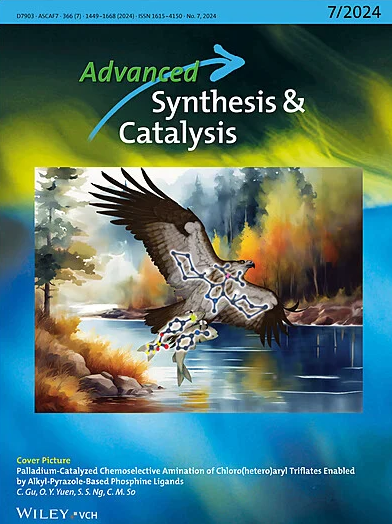Synthesis of Tetrahydroisoquinolin‐4‐Ones via Rh(II)‐Catalyzed One‐Pot Reaction of Aldehyde‐Tethered N‐Sulfonyl‐1,2,3‐Triazoles with Indoles
IF 4.4
2区 化学
Q2 CHEMISTRY, APPLIED
引用次数: 0
Abstract
A rhodium (II)‐catalyzed transannulation reaction between aldehyde‐tethered N‐sulfonyl‐1,2,3‐triazoles and indoles was reported, which resulted in the formation of functionalized tetrahydroisoquinolin‐4‐ones. This reaction is notable for its broad substrate scope, including a variety of N‐sulfonyl‐1,2,3‐triazoles and different indoles. The addition of a protonic acid is essential for improving the yield of the desired tetrahydroisoquinolin‐4‐one products.
Rh(II)催化醛系n-磺酰基-1,2,3-三唑与吲哚的一锅反应合成四氢异喹啉-4-酮
报道了在铑(II)催化下,醛系n-磺酰基-1,2,3-三唑与吲哚发生环交联反应,生成了功能化的四氢异喹啉-4-酮。该反应以其广泛的底物范围而闻名,包括各种n -磺酰-1,2,3-三唑和不同的吲哚。质子酸的加入是提高四氢异喹啉-4- 1产品收率所必需的。
本文章由计算机程序翻译,如有差异,请以英文原文为准。
求助全文
约1分钟内获得全文
求助全文
来源期刊

Advanced Synthesis & Catalysis
化学-应用化学
CiteScore
9.40
自引率
7.40%
发文量
447
审稿时长
1.8 months
期刊介绍:
Advanced Synthesis & Catalysis (ASC) is the leading primary journal in organic, organometallic, and applied chemistry.
The high impact of ASC can be attributed to the unique focus of the journal, which publishes exciting new results from academic and industrial labs on efficient, practical, and environmentally friendly organic synthesis. While homogeneous, heterogeneous, organic, and enzyme catalysis are key technologies to achieve green synthesis, significant contributions to the same goal by synthesis design, reaction techniques, flow chemistry, and continuous processing, multiphase catalysis, green solvents, catalyst immobilization, and recycling, separation science, and process development are also featured in ASC. The Aims and Scope can be found in the Notice to Authors or on the first page of the table of contents in every issue.
 求助内容:
求助内容: 应助结果提醒方式:
应助结果提醒方式:


